Sharp Bundle
Who Really Owns Sharp Corporation?
Understanding a company's ownership structure is key to grasping its future. The story of Sharp Corporation, a titan in the electronics world, is a compelling case study in how ownership shifts can redefine a business. From its humble beginnings to its current status, the Sharp SWOT Analysis reveals a complex evolution.
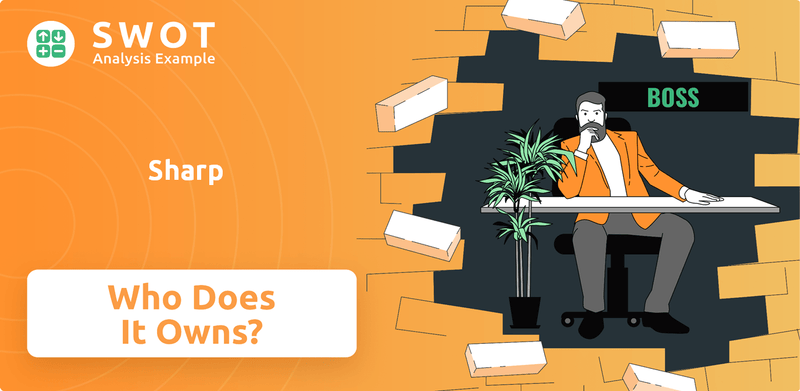
This deep dive into Sharp ownership will explore the dramatic changes that have shaped this iconic Japanese company. We'll uncover the pivotal role of Foxconn, the current owner of Sharp, and examine how these ownership dynamics have impacted Sharp's strategic direction, its products, and its position in the global market. Discover the details of Sharp's history, from its roots in Japan to its current global footprint.
Who Founded Sharp?
The story of Sharp Corporation begins with Tokuji Hayakawa, who established a metal workshop in Tokyo in 1912. His inventive spirit led to the creation of the 'Ever-Ready Sharp' mechanical pencil, which would later give the company its name. This marked the beginning of what would become a major player in the electronics industry.
Hayakawa formally founded 'Hayakawa Metal Works' in 1924 in Osaka, after the Great Kantō earthquake destroyed his original business. The company's evolution continued with a name change to 'Hayakawa Electric Industry Company' in 1942. Early on, Sharp expanded beyond pencils, venturing into electronics and other metal products, setting the stage for its future innovations.
The company's trajectory included significant milestones, such as producing Japan's first crystal radio in 1925 and the first TV sets in 1953. The name 'Sharp Corporation' was adopted in 1970, the same year Tokuji Hayakawa stepped down as president. The early ownership structure reflects a strong entrepreneurial foundation, driven by Hayakawa's vision and innovative products.
Tokuji Hayakawa's initial invention was the snap buckle 'Tokubijo'. The 'Ever-Ready Sharp' mechanical pencil was a pivotal product. The company's early diversification included metal products and electronics.
1912: Tokuji Hayakawa establishes a metal workshop. 1924: 'Hayakawa Metal Works' is formally established. 1942: The company's name changes to 'Hayakawa Electric Industry Company'.
1925: Sharp assembled Japan's first crystal radio. 1953: Production of Japan's first TV sets, the 'Sharp TV3-14T', began. This marked a significant expansion into the electronics sector.
In 1970, the company's name was officially changed to Sharp Corporation. This coincided with Tokuji Hayakawa's retirement as president, signifying a transition in leadership.
Specific equity splits of the founders and early investors aren't available in the provided sources. The company's growth was driven by innovation and the founder's vision. This strong entrepreneurial foundation is key.
Beyond mechanical pencils, Sharp diversified into various metal products. The introduction of crystal radios and TVs marked a significant expansion. The company's product range evolved over time.
While specific details about early shareholders are not readily available, the company's history underscores a focus on innovation and product development. Understanding the Marketing Strategy of Sharp can provide further insights into how the company evolved and maintained its market position over the years. The company's early success was built on the vision of its founder and a commitment to technological advancement, which continues to influence its operations today. As of the latest available data, the company continues to be a significant player in the global electronics market.
Sharp SWOT Analysis
- Complete SWOT Breakdown
- Fully Customizable
- Editable in Excel & Word
- Professional Formatting
- Investor-Ready Format
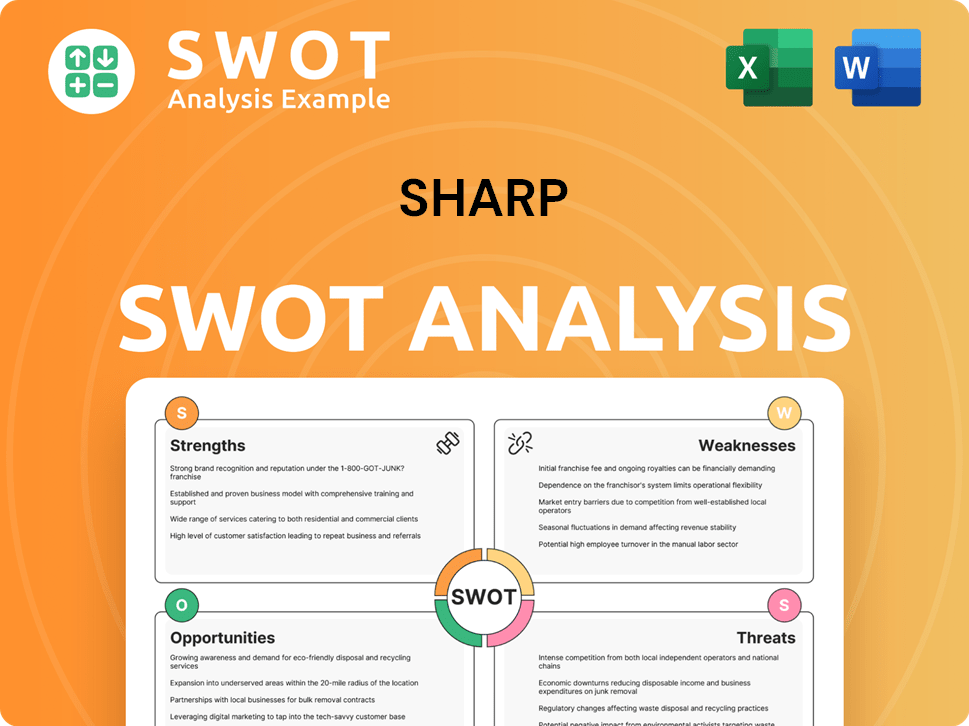
How Has Sharp’s Ownership Changed Over Time?
The ownership of Sharp Corporation has seen a significant transformation, especially since 2016. This was when Hon Hai Precision Industry Co., Ltd., also known as Foxconn, took over the majority ownership. This move marked the first time a major Japanese consumer electronics company was acquired by a foreign entity. This shift has greatly influenced the company's direction and how it's managed.
The evolution of Sharp's ownership includes key events like Samsung's US$100 million investment in March 2013, which gave Samsung a 3.04% stake. Later, in 2018, Sharp acquired Dynabook from Toshiba, making it a wholly-owned subsidiary by August 2020. These changes highlight a move from being mainly Japanese-owned to one with considerable foreign and institutional influence. For more details, take a look at the Brief History of Sharp.
| Shareholder | Shares Held (as of March 31, 2025) | Percentage of Total Shares |
|---|---|---|
| Hon Hai Precision Industry Co., Ltd. | 144,900,000 | 22.32% |
| SIO International Holdings Limited | 85,884,845 | 13.23% |
| Foxconn (Far East) Limited | 76,655,069 | 11.81% |
| Foxconn Technology Pte. Ltd. | 64,640,000 | 9.96% |
As of February 4, 2025, Hon Hai Precision Industry Co., Ltd. held the largest share with 34% of outstanding shares. Other Foxconn-related entities held 13% and 10% respectively. Public companies, including Foxconn, collectively possess 44% of the shares, while individual investors hold 26%. Institutional ownership accounts for 13%. Sharp's financial performance has shown fluctuations, with net sales peaking at ¥2,548,117 million in 2023 and decreasing to ¥2,321,921 million in 2024. The company also reported substantial losses in fiscal years 2022 and 2023.
The ownership of Sharp Corporation is primarily controlled by Foxconn and related entities. This shift has changed the company's strategic direction and financial outcomes.
- Foxconn is the majority owner of Sharp.
- Significant stakes are held by Foxconn-related entities.
- Individual investors and institutional investors also hold shares.
- Sharp's financial performance has seen fluctuations.
Sharp PESTLE Analysis
- Covers All 6 PESTLE Categories
- No Research Needed – Save Hours of Work
- Built by Experts, Trusted by Consultants
- Instant Download, Ready to Use
- 100% Editable, Fully Customizable
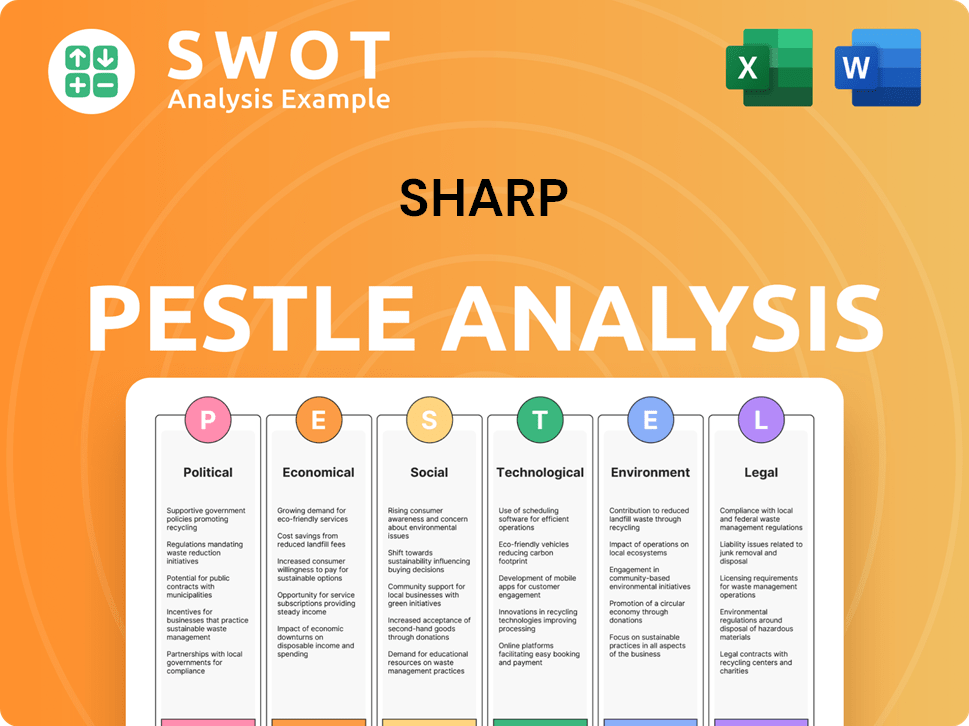
Who Sits on Sharp’s Board?
The Board of Directors at Sharp Corporation is pivotal in guiding the company's strategy and governance, alongside its major shareholders. While the complete roster and affiliations of all board members aren't fully detailed across the provided sources, the substantial influence of Foxconn, as the majority owner, suggests a significant presence or alignment of interests on the board. As of June 27, 2024, Masahiro Okitsu serves as the President and CEO, succeeding Wu Po-Hsuan, who transitioned to Deputy Chairman.
The governance structure at Sharp reflects the influence of its major shareholders, particularly Foxconn. The Board of Directors is responsible for proposing candidates for directors to the General Meeting of Shareholders and appointing executive officers. Sharp's policies ensure that transactions with the controlling shareholder, Foxconn, are conducted only when their necessity, validity, and rationality are established, potentially reviewed by a special committee of independent outside board members.
| Board Member | Position | Notes |
|---|---|---|
| Masahiro Okitsu | President and CEO | Effective June 27, 2024 |
| Po-Hsuan Wu | Deputy Chairman | Former President and CEO |
The voting structure at Sharp, a publicly traded company, generally follows a one-share-one-vote principle. However, the significant shareholding by Foxconn, holding over 57% of the company's shares as of February 4, 2025, grants them substantial control and voting power. This concentration of ownership enables these entities to significantly influence management and governance decisions. The Board of Directors regularly reviews the economic rationale and future outlook of major cross-shareholdings, exercising voting rights to improve Sharp's long-term corporate value.
Sharp's Board of Directors plays a crucial role in the company's governance, especially with Foxconn's significant ownership. The board proposes director candidates and appoints executive officers. Transactions with Foxconn are carefully managed to ensure fairness and validity.
- Foxconn holds over 57% of Sharp's shares, as of February 4, 2025.
- Masahiro Okitsu is the current President and CEO.
- The board reviews cross-shareholdings for long-term value.
- Transactions with Foxconn are scrutinized.
Sharp Business Model Canvas
- Complete 9-Block Business Model Canvas
- Effortlessly Communicate Your Business Strategy
- Investor-Ready BMC Format
- 100% Editable and Customizable
- Clear and Structured Layout
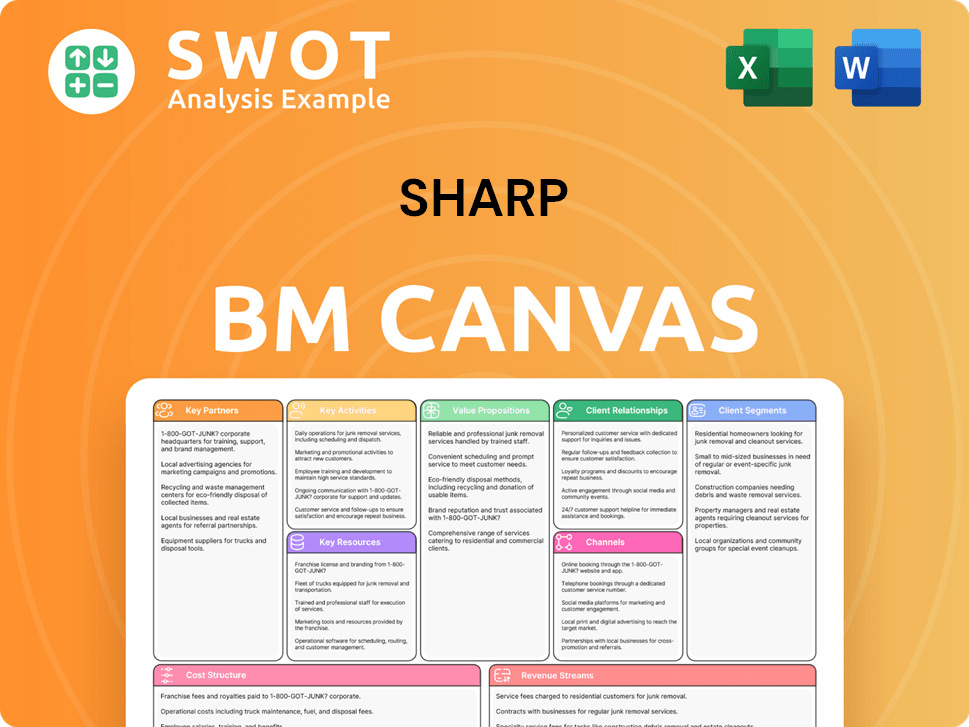
What Recent Changes Have Shaped Sharp’s Ownership Landscape?
Over the past few years, significant shifts have occurred in the ownership of Sharp Corporation, largely influenced by its majority owner, Foxconn. In May 2024, Sharp announced its exit from the TV display business, including the closure of production lines in Japan and the potential sale of related businesses. This strategic move is part of Foxconn's broader 'structural reform and revival plan' due to Sharp's operating losses and financial decline, with substantial losses recorded in fiscal years 2022 and 2023. Foxconn's CFO reported a non-operating loss of $330 million USD (NT$10.5 billion) in Q1 2024 for Sharp.
Further illustrating the restructuring, Sharp announced on April 23, 2025, the sale of its subsidiary, Sharp Fukuyama Laser (SFL), to Hon Hai Technology's investment arm for JPY 15.5 billion. This transaction, expected by September 29, 2025, is a related party transaction. Additionally, Sharp plans to sell its Gen 8 display factory in Kameyama, Japan, to Hon Hai Group, with the transition expected before August 2026, after which Sharp will purchase panels from Hon Hai Group. The Target Market of Sharp is also influenced by these ownership changes.
Other recent activities include Sharp acquiring the remaining shares of Dynabook from Toshiba in August 2020, making Dynabook Inc. a wholly-owned subsidiary. In December 2024, Sharp Therapeutics Corp. completed a reverse takeover, with EVP Capital Inc. acquiring Sharp Edge Labs, Inc., and EVP Capital Inc. being renamed Sharp Therapeutics Corp.. This resulted in William R. Newlin holding beneficial ownership and control over approximately 17.2% of the issued and outstanding shares of the newly formed Sharp Therapeutics. On January 16, 2025, Sharp Therapeutics Corp. also announced a share consolidation on a 10-to-1 basis, approved by shareholders in December 2024, to attract future financings and improve trading liquidity.
| Ownership Trend | Details | Date |
|---|---|---|
| Exit from TV Display Business | Closure of production lines and potential sale of related businesses. | May 2024 |
| Sale of SFL | Sale of Sharp Fukuyama Laser to Hon Hai Technology's investment arm for JPY 15.5 billion. | April 23, 2025 (Announced) |
| Sale of Gen 8 Display Factory | Sale of factory in Kameyama, Japan, to Hon Hai Group. | Before August 2026 |
| Dynabook Acquisition | Sharp acquired remaining shares, making Dynabook Inc. a wholly-owned subsidiary. | August 2020 |
| Sharp Therapeutics Reverse Takeover | EVP Capital Inc. acquired Sharp Edge Labs, Inc., renamed Sharp Therapeutics Corp. | December 2024 |
| Share Consolidation | Sharp Therapeutics Corp. announced a 10-to-1 share consolidation. | January 16, 2025 (Announced) |
As of February 4, 2025, public companies hold 44% of Sharp's shares, and institutional ownership stands at 13%.
Major institutional shareholders include Vanguard Total International Stock Index Fund, Vanguard Developed Markets Index Fund, and iShares Core MSCI EAFE ETF.
Foxconn's strategic initiatives are aimed at restructuring and optimizing Sharp's business operations.
Sharp has been facing operating losses and a decline in financial position, recording substantial losses in fiscal years 2022 and 2023.
Sharp Porter's Five Forces Analysis
- Covers All 5 Competitive Forces in Detail
- Structured for Consultants, Students, and Founders
- 100% Editable in Microsoft Word & Excel
- Instant Digital Download – Use Immediately
- Compatible with Mac & PC – Fully Unlocked
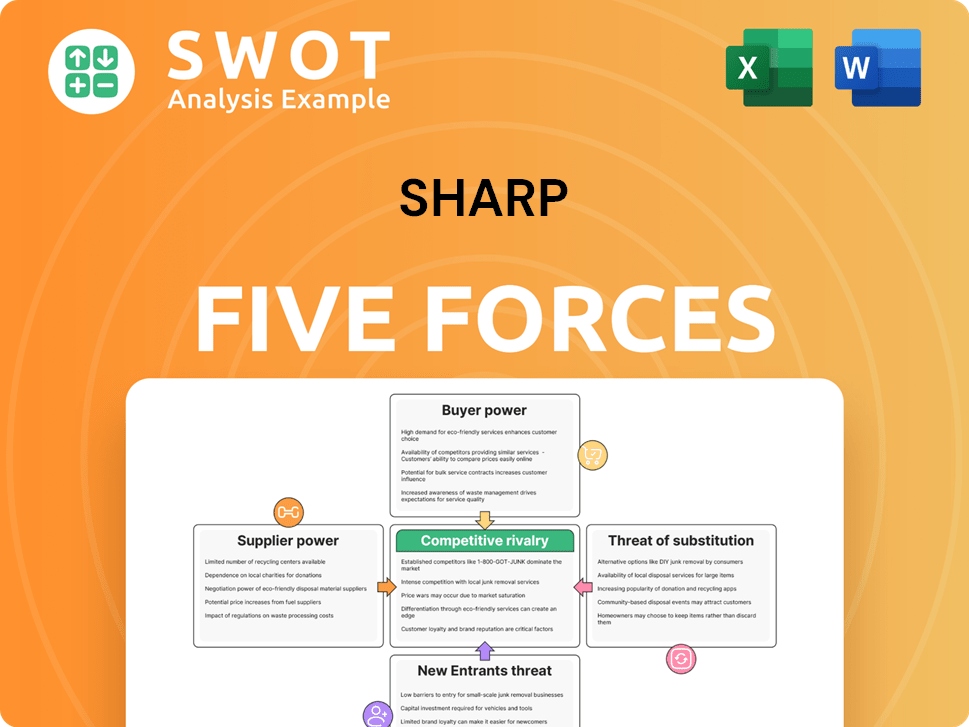
Related Blogs
- What are Mission Vision & Core Values of Sharp Company?
- What is Competitive Landscape of Sharp Company?
- What is Growth Strategy and Future Prospects of Sharp Company?
- How Does Sharp Company Work?
- What is Sales and Marketing Strategy of Sharp Company?
- What is Brief History of Sharp Company?
- What is Customer Demographics and Target Market of Sharp Company?
Disclaimer
All information, articles, and product details provided on this website are for general informational and educational purposes only. We do not claim any ownership over, nor do we intend to infringe upon, any trademarks, copyrights, logos, brand names, or other intellectual property mentioned or depicted on this site. Such intellectual property remains the property of its respective owners, and any references here are made solely for identification or informational purposes, without implying any affiliation, endorsement, or partnership.
We make no representations or warranties, express or implied, regarding the accuracy, completeness, or suitability of any content or products presented. Nothing on this website should be construed as legal, tax, investment, financial, medical, or other professional advice. In addition, no part of this site—including articles or product references—constitutes a solicitation, recommendation, endorsement, advertisement, or offer to buy or sell any securities, franchises, or other financial instruments, particularly in jurisdictions where such activity would be unlawful.
All content is of a general nature and may not address the specific circumstances of any individual or entity. It is not a substitute for professional advice or services. Any actions you take based on the information provided here are strictly at your own risk. You accept full responsibility for any decisions or outcomes arising from your use of this website and agree to release us from any liability in connection with your use of, or reliance upon, the content or products found herein.